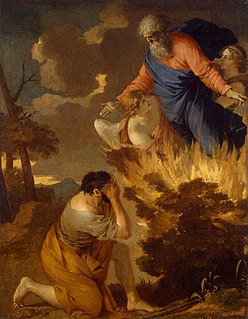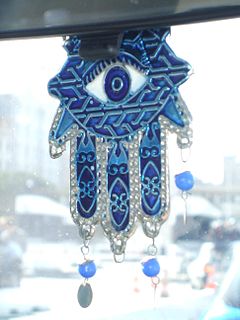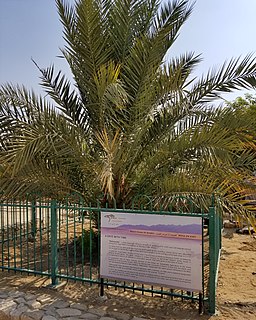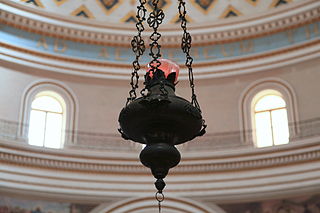 W
WTekhelet in Judaism is the holiest color of Judaism. It is a blue or violet dye.
 W
WThe burning bush was a supernatural phenomenon described by Exodus 3:1–4:17 that occurred on Mount Horeb. According to the biblical account, the bush was on fire, but was not consumed by the flames, hence the name. In the biblical narrative, the burning bush is the location at which Moses was appointed by Yahweh to lead the Israelites out of Egypt and into Canaan.
 W
WChai figures prominently in modern Jewish culture; the Hebrew letters of the word are often used as a visual symbol.
 W
WEtrog is the yellow citron or Citrus medica used by Jews during the week-long holiday of Sukkot as one of the four species. Together with the lulav, hadass, and aravah, the etrog is taken in hand and held or waved during specific portions of the holiday prayers. Special care is often given to selecting an etrog for the performance of the Sukkot holiday rituals.
 W
WThe hamsa is a palm-shaped amulet popular throughout the Maghreb and in the Middle East and commonly used in jewelry and wall hangings. Depicting the open right hand, an image recognized and used as a sign of protection in many times throughout history, the hamsa is believed by Middle Easterners, to provide defense against the evil eye. The hamsa holds recognition as a bearer of good fortune among Christians in the Middle East as well.
 W
WJewish heraldry is the tradition and style of heraldic achievements amongst Jewish communities throughout Europe and abroad. Included are the national and civic arms of the State of Israel, noble and burgher arms, synagogal heraldry, heraldic displays and heraldic descriptions. Jewish Heraldry is commonly influenced by its country of origin, yet often preserves common Jewish symbolisms such as the Lion of Judah or the Star of David.
 W
WThe Hebrew word for 'symbol' is ot, which, in early Judaism, denoted not only a sign, but also a visible religious token of the relation between God and human.
 W
WThe Judean date palm is a date palm grown in Judea. It is not clear whether there was ever a single distinct Judean cultivar, but dates grown in the region have had distinctive reputations for thousands of years, and the date palm was anciently regarded as a symbol of the region and its fertility. Cultivation of dates in the region almost disappeared after the fourteenth century AD from a combination of climate change and infrastructure decay but has been revived in modern times.
 W
WThe Lion of Judah is a Jewish national and cultural symbol, traditionally regarded as the symbol of the Israelite tribe of Judah. According to the Torah, the tribe consists of the descendants of Judah, the fourth son of Jacob. The association between Judah and the lion can first be found in the blessing given by Jacob to his son Judah in the Book of Genesis.
 W
WA sanctuary lamp, chancel lamp, altar lamp, everlasting light, or eternal flame is a light that shines before the altar of sanctuaries in many Jewish and Christian places of worship. Prescribed in Exodus 27:20-21 of the Torah, this icon has taken on different meanings in each of the religions that have adopted it. The passage, which refers to prescriptions for the tabernacle, states:And thou shalt command the children of Israel, that they bring thee pure oil olive beaten for the light, to cause the lamp to burn always. In the tabernacle of the congregation without the veil, which is before the testimony, Aaron and his sons shall order it from evening to morning before the LORD: it shall be a statute for ever unto their generations on the behalf of the children of Israel. (KJV)
 W
WA shofar is an ancient musical horn typically made of a ram's horn, used for Jewish religious purposes. Like the modern bugle, the shofar lacks pitch-altering devices, with all pitch control done by varying the player's embouchure. The shofar is blown in synagogue services on Rosh Hashanah and at the end of Yom Kippur; it is also blown every weekday morning in the month of Elul running up to Rosh Hashanah. Shofars come in a variety of sizes and shapes, depending on the choice of animal and level of finish.
 W
WThe Star of David, known in Hebrew as Magen David, is a generally-recognized symbol of modern Jewish identity and Judaism. Its shape is that of a hexagram, the compound of two equilateral triangles.
 W
WThe menorah is described in the Bible as the seven-lamp ancient Hebrew lampstand made of pure gold and used in the tabernacle set up by Moses in the wilderness and later in the Temple in Jerusalem. Fresh olive oil was burned daily to light its lamps. The menorah was a symbol of both Judaism and Christianity since antiquity; in modern times it is primarily considered a symbol of Judaism and is the emblem on the coat of arms of the modern state of Israel.
 W
WYesod is a sephirah or node in the kabbalistic Tree of Life, a system of Jewish philosophy. Yesod, located near the base of the Tree, is the sephirah below Hod and Netzach, and above Malkuth. It is seen as a vehicle allowing movement from one thing or condition to another. Yesod, Kabbalah, and the Tree of Life are Jewish concepts adopted by various philosophical systems including Christianity, New Age Eastern-based mysticism, and Western esoteric practices.
 W
WA number of Yiddish symbols have emerged to represent the language and the Yiddishist movement over history. Lacking a central authority, however, they have not had the prominence of those of the Hebrew revival and the Zionist symbols of Israel. Several of the Yiddish symbols are drawn from Yiddish songs in the klezmer tradition.